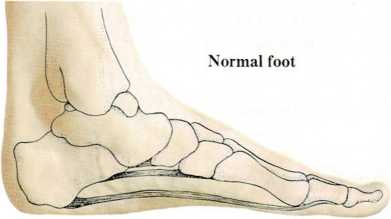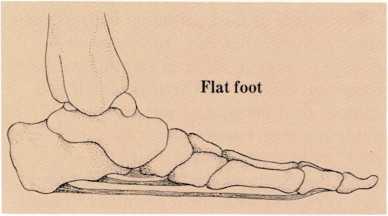Flat Feet – Foot Care
Normal foot and flat foot


The bones in the arch of a normal foot are supported by muscles and
ligaments. When these muscles and ligaments are weak, the arch
flattens.
Flat feet. The arch of the foot consists of several bones, all
fitting next to one another in a curve that is supported by muscles and
ligaments that attach to the bones. When these muscles and ligaments are
weak, the arch relaxes and flattens out, and the child appears to have
flat feet. Soreness, pain, and fatigue in the legs may develop.
Most babies look as though they have flat feet. This is because their
feet are naturally plump, and fat partially hides the foot arch. With
use, and the ability to walk, the child’s muscles and ligaments
strengthen and hold the bones of the foot in a firmer arch. If your
child still appears to have flat feet at about 2 years of age, or if
your child has complaints of pain in the feet or legs or of tiring
easily, consult your doctor. The doctor may suggest using coiTective
devices in the shoes.
When your child is about 2 years old, it is best to have the child wear
shoes with flat, flexible soles. These soles allow the muscles and
ligaments of the child’s feet and ankles to move and become stronger.
At any age, it is best to have a child wear shoes with flat, flexible
soles. Babies do not need hard-soled or high-top shoes when learning to
walk. [jj.g.]
Flu. See Influenza
Food poisoning can result from eating food that is contaminated by
bacteria or by chemicals. Some mushrooms and other plants can also cause
food poisoning.
Symptoms of food poisoning include nausea, vomiting, diarrhea, and
stomach cramps. Younger children and infants may have convulsions. Call
your doctor if you suspect food poisoning. Serious cases of food
poisoning may require hospitalization. However, most types of food
poisoning are rarely fatal. Botulism, a rare type of food poisoning that
is caused by a toxin produced in bacteria, may paralyze the muscles used
in breathing and cause death by suffocation.
Food poisoning usually occurs because food has been prepared, canned, or
stored under unsanitary conditions. Potato salad, meat salads, custards,
chicken, and similar foods easily become contaminated by bacteria. Keep
these foods refrigerated until they are served, [m.g.]
See also Poisonings and poisons
Foot care. Probably the most common questions parents ask about
their child’s feet are, “When should the child start wearing shoes?” and
“What type of shoes should be worn?” For the first year, a baby does not
need shoes. A child does not even need bootees or socks on the feet
unless the house or floor is unusually cold. Buy the first pair of shoes
for your child when the baby begins active, unassisted walking.
The proper first shoes should have flat, flexible soles. There is no
longer believed to be any specific advantage in letting your child go
barefoot for prolonged periods once active, unassisted walking has
begun.
Does the shoe fit the child properly? When the child stands, the longest
toe should be from \’A to V2 inch (6 to 13 millimeters) from the end
of the shoe. To check the width of a
shoe, lightly pinch the material over the child’s toes. It should form a
little fold if the shoe is wide enough. Later, when your child wears
sturdier shoes, you can check the width by pressing in the sides of the
shoe while the child is standing. If the shoe is wide enough, a slight
bulge should form.
Proper fitting socks are important, too. Your child’s socks, like the
shoes, should have from W to \’/a inch (6 to 13 millimeters) extra room
at the end. Cotton and wool are the best materials for socks, because
they cushion the foot and absorb moisture. Change your child’s socks
every day. When children are old enough to put on their own socks,
parents should check to see that they are put on correctly, with the
heel of the sock covering the heel of the foot.
Until your child is about 5 or 6 years old, check the shoes every few
weeks to be certain they are still long and wide enough.
The average toddler needs a new pair of shoes about every three or four
months. Children usually outgrow their shoes before they wear them out,
but never let a child wear a pair of shoes that are run-down at the
heels or on the soles. Run-down shoes put extra pressure on parts of the
child’s feet and may cause aching feet, calluses, and other foot
disorders.
Children may not always tell you that their shoes do not fit or that
they hurt their feet. Look for certain signs. The shoes are probably too
small if children appear to walk with discomfort or tend to take the
shoes off on coming into the house. Another indication of short shoes is
redness at the base of the big toenails. Red spots or blisters indicate
that the shoes may be rubbing the feet.
Do not pass shoes down from an older child to a younger child. Feet have
different shapes, and the older child’s shoes will be impressed with the
shape of the child’s feet. Even though hand-me-down shoes may be the
correct size, they can force the younger child’s feet out of their own
individual shape and into the shape of the shoes, [jj.g.]
See also Bowlegs; Flat feet; Hip, congenital dislocation; Knock-knee;
Nail care; Ringworm; Warts
Fracture. See Broken bones
